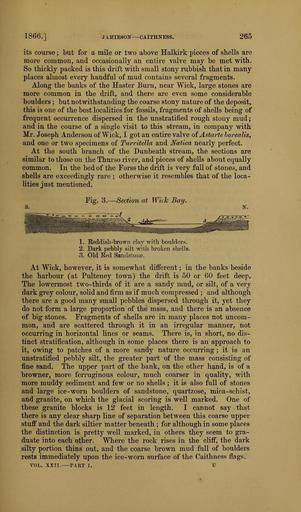MAKE A MEME
View Large Image

| View Original: | The_Quarterly_journal_of_the_Geological_Society_of_London_(13935373771).jpg (1207x2055) | |||
| Download: | Original | Medium | Small | Thumb |
| Courtesy of: | commons.wikimedia.org | More Like This | ||
| Keywords: The Quarterly journal of the Geological Society of London (13935373771).jpg 1866 JAMIE80N CAITHNESS 265 <br> its course ; but for a mile or two above Halkirk pieces of shells are <br> more common and occasionally an entire valve may be met with <br> So thickly packed is this drift with small stony rubbish that in many <br> places almost every handful of mud contains several fragments <br> Along the banks of the Haster Burn near Wick large stones are <br> more common in the drift and there are even some considerable <br> boulders ; but notwithstanding the coarse stony nature of the deposit <br> this is one of the best localities for fossils fragments of shells being of <br> frequent occurrence dispersed in the unstratified rough stony mud ; <br> and in the course of a single visit to this stream in company with <br> Mr Joseph Anderson of Wick I got an entire valve ofAstarte horealisy <br> and one or two specimens of Turritella and Nat lea nearly perfect <br> At the south branch of the Dunbeath stream the sections are <br> similar to ihose on the Thurso river and pieces of shells about equally <br> common In the bed of the Forss the drift is veiy full of stones and <br> shells are exceedingly rare ; otherwise it resembles that of the loca- <br> lities just mentioned <br> Pig 3 ” Section at Wick Bay <br> i- -;r-;i-7r x <br> 1 Reddisli-brown clay with boulders <br> 2 Dark pebbly silt with bi'oken shells <br> 3 Old Red Sandstone <br> At Wick however it is somewhat different ; in the banks beside <br> the harbour at Pulteney town the drift is 50 or 60 feet deep <br> The lowermost two- thirds of it are a sandy mud or silt of a very <br> dark grey colour solid and firm as if much compressed ; and although <br> there are a good many small pebbles dispersed through it yet they <br> do not form a large proportion of the mass and there is an absence <br> of big stones Fragments of shells are in many places not uncom- <br> mon and are scattered through it in an irregular manner not <br> occurring in horizontal lines or seams There is in short no dis- <br> tinct stratification although in some places there is an approach to <br> it owing to patches of a more sandy nature occurring ; it is an <br> imstratified pebbly silt the greater part of the mass consisting of <br> fine sand The upper part of the bank on the other hand is of a <br> browner more ferruginous colour much coarser in quality with <br> more muddy sediment and few or no shells ; it is also full of stones <br> and large ice-worn boulders of sandstone quartzose mica-schist <br> and granite on which the glacial scoring is well marked One of <br> these granite blocks is 12 feet in length I cannot say that <br> there is any clear sharp line of separation between this coarse upper <br> stuff and the dark siltier matter beneath ; for although in some places <br> the distinction is pretty well marked in others they seem to gra- <br> duate into each other Where the rock rises in the cliff the dark <br> silty portion thins out and the coarse brown mud full of boulders <br> rests immediately upon the ice-worn surface of the Caithness flags <br> VOL XXII PART I U 36164694 111477 51125 Page 265 Text v 22 http //www biodiversitylibrary org/page/36164694 1866 Geological Society of London NameFound Turritella NameConfirmed Turritella EOLID 52187 NameBankID 2683895 Biodiversity Heritage Library The Quarterly journal of the Geological Society of London v 22 1866 Geology Periodicals Smithsonian Libraries bhl page 36164694 dc identifier http //biodiversitylibrary org/page/36164694 smithsonian libraries Information field Flickr posted date ISOdate 2014-04-21 Check categories 2015 August 26 CC-BY-2 0 BioDivLibrary https //flickr com/photos/61021753 N02/13935373771 2015-08-26 06 55 35 cc-by-2 0 PD-old-70-1923 The Quarterly journal of the Geological Society of London 1866 Photos uploaded from Flickr by Fæ using a script | ||||